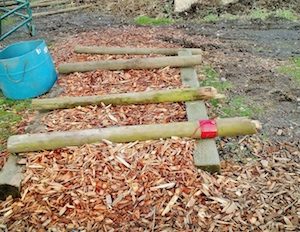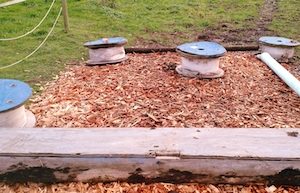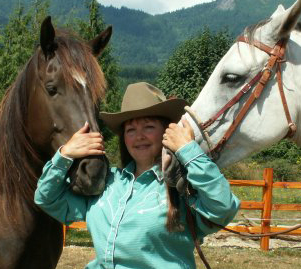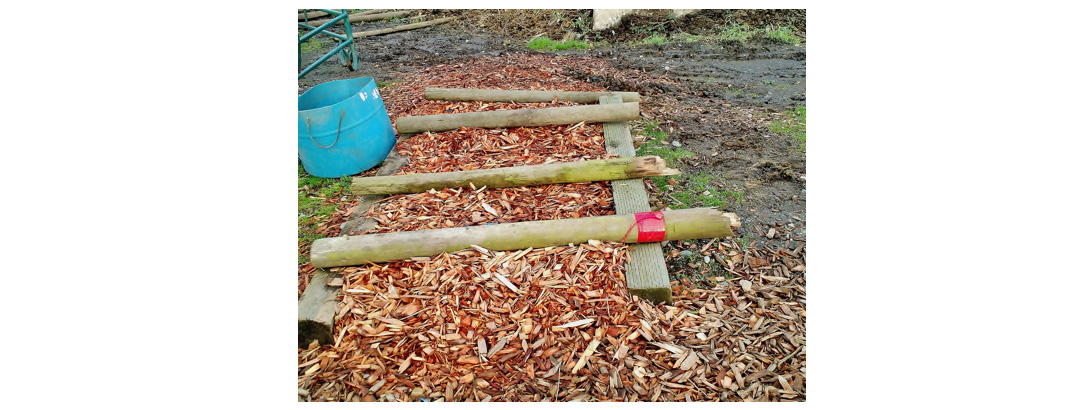Creativity Saves Money
by Wendy Croney

Another new year, another opportunity for budget friendly tips on how to care for our favorite four-legged friend — the horse!
Here at Galloping Horse Equestrian my goal is to work hard each day to give great care to my beloved horses. I’m constantly on the lookout for new ideas to streamline our program. This year, while pondering how to ease the muddy trek from the field to the barn, I had a great idea. (Well, we’ll see by spring if it’s still a great idea.) So far it’s been wonderful. The ground around the gates, a shelter, and heavily used paths throughout the acreage is much more pleasant for the horses as well as their handler than it was last winter.
This brainstorm was spawned by something I did two years ago in a long lane that the horses use to get from field to barnyard. It was simple and completely free; I placed logs across the lane about every 3 to 4 feet so the horses had to slow to a careful walk while traversing the lane.
This prevents the horses from churning the land into deep mud by madly dashing through it when the dinner bell rings. It’s a blast watching them race each other to the barn, then suddenly stop, slowly walking the rest of the 200 or so feet like ladies and gentleman stepping over all those logs.
Several areas around here needed more than an obstacle to prevent a mud issue. I knew I needed to put something in the trouble spots to firm up these areas. So, in pondering what material to use for mud control, my first choice was gravel (spendy!); my second choice was hog fuel (less spendy). Gravel doesn’t rot and turn to mush as do wood pieces, but I’ve used gravel for years in paddocks and it eventually disappears down into the mud. Hog fuel is less expensive and many people use it because of this factor, though it doesn’t hold up as well as gravel. It disappears into the mud even more quickly than gravel, but the cost difference is significant. So what does the budget-wise equestrian do?
I’ve done a bit of experimenting, and discovered that both materials perform much better if you lay road fabric down then put your hog fuel (or gravel) on top. Either material will become firmer and won’t disappear into the mud. If the horses are prevented from dashing through and tearing it up it will last even longer.

This is what I did: purchased road fabric, purchased a load of hog fuel, procured an assortment of unwanted round fence posts, 4×4 lengths of lumber, and a few railroad ties.
Then I laid road fabric in the potentially muddy areas. I covered that with a thick layer of hog fuel, about 8” deep. I then used some of the 4×4’s as borders to keep the material from spreading off of the area I where I wanted it. Next, I put some of the logs, posts, and 4×4’s across about 3 to 4 feet apart along this “mud bridge”. The obstacles encourage the horses to slowly walk through the newly prepared area.
Here’s another thrifty idea: I put my creations in a lane that is much narrower than the actual gate opening, but wide enough for the horses to walk single file across. Not covering the entire pathway allowed me to save on product. Don’t fret if your suspicious prey animals choose to walk around the strange looking new thing suddenly appearing in their world! As that ground deteriorates over time they will choose to use the dry mud-free area.
Another idea I used with one wider pass-through was to put different kinds of obstacles in the way so the horses will choose the hog fuel trail instead of going around, and have to pick their way through some obstacles instead of just stepping over logs.
I decided to write about this subject this month because I know that countless equestrians have mud, and I’ve never seen this solution in any other barn. I hope this idea proves helpful to readers.
I also have another helpful way to overcome drainage problems in muddy barnyards and paddocks; it’s incredibly easy and cost effective compared to digging and installing drainage. We are working with this new method on our property, but that’s a story for another time.
I wish you a happy new year, and I welcome NW Horse Source readers to share your great ideas with me. Now go enjoy those beautiful horses!
Originally Published January 2017 Issue

Wendy Croney has owned and ridden horses her entire life, discovering she has a true talent for effective, gentle horse training as well as teaching horseback riding. She has been training, teaching horsemanship and giving lessons in multiple disciplines for more than 30 years using her own methods developed through experience, as well as learning from Richard Shrake, Clinton Anderson and many others. Wendy is known for an economic approach to horse care and personally provides it to her own horses, including hoof trims. She focuses on creative ways to keep horses as naturally as possible on a tight budget. Wendy has retired from her business, “Galloping Horse Equestrian” in Colorado Springs, CO, however she is still available for consulting and continues the quest to provide the finest horse care for the most effective cost.






